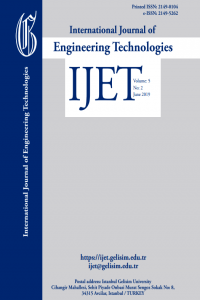Testing of Maturity Methods for Concrete Quality Cured Using Various Temperatures
Maturity of concrete is a subject of utmost essence in all phases of a construction project that has to be dealt with care and accordingly important advantages may be gained with optimum predictions. In this study, concrete specimens at various strength classes were prepared to investigate on the effect of concrete class on two different maturity function given in literature. Procedures were handled in accordance with the prescriptions given in ASTM C 1074. Recommendations given in the same standard for standard cement type was discussed and convenience of two different maturity functions were analyzed. Important values obtained from mortar specimens tests were applied to maturity calculations of concrete mixtures and applicability of the methods were discussed. It is found that with the increasing concrete quality, for two extreme temperatures (8 and 25 ˚C) in this study, important deviations in the results are observed. Results obtained from specimens cured at 36 ˚C were found to be significantly higher than specimens cured at 8 ˚C at higher maturity levels. Datum temperature and Q-values data obtained from mortar mixtures were applied to concrete specimens and it may be asserted that concrete specimens demonstrated good correlation with the findings of both maturity functions. Generally, it may be expressed that maturity functions behave well under normal temperatures however applicability at extreme temperatures should be limited.
Keywords:
maturity, rapid curing, early strength curing temperature, Nurse-saul,
___
- S. J. Barnett, M. N. Soutsos, J. H. Bungey, and S. G. Millard, “Fast-track construction with slag cement concrete: adiabatic strength development and strength prediction”, ACI Materials Journal, vol. 104, no. 4, pp. 388–396, 2007. (Article)
- T. Kim and K. L. Rens, “Concrete maturity method using variable temperature curing for normal and high-strength concrete. I: Experimental study”, Journal of Materials in Civil Engineering, Vol. 20, No. 12, pp. 727-734, 2008. (Article)
- C. H. Lee and K. C. Hover, “Influence of datum temperature and activation energy on maturity strength predictions”, ACI Materials Journal, Vol. 112, No. 6, pp.781-790, 2015. (Article)
- A. G. A Saul, “Principles Underlying the Steam Curing of Concrete at Atmospheric Pressure”, Magazine of Concrete Research, Vol. 2, No. 6, pp. 127-140, 1951. (Article)
- P. Freiesleben Hansen, and J. Pedersen, “Maturity computer for controlled curing and hardening of concrete”, Nordisk Betong, Vol 1, pp.19-34, 1975. (Article)
- N. J. Carino and R. C. Tank, “Maturity functions for concretes made with various cements and admixtures”, ACI Materials Journal, Vol. 89, pp. 188-196, 1992. (Article)
- R. C. Tank and N. J. Carino, “Rate constant functions for strength development of concrete”, ACI Materials Journal, Vol. 88, No. 1, pp.74-83, 1991. (Article)
- A. G. Brooks, A. K. Schindler and R. W. Barnes, “Maturity method evaluated for various cementitious materials”, J. Mater. Civil Eng., Vol. 19, No.12, pp. 1017-1025, 2007. (Article)
- S. A. Wade, J. M. Nixon, A. K. Schindler and R.W. Barnes, “Effect of temperature on the setting behavior of concrete”, J. Mater. Civil Eng., pp. 214–222, 2010. (Article)
- R.C.A. Pinto and A.K. Schindler, “Unified modeling of setting and strength development”, Cement and Concrete Research, Vol. 40, pp. 58–65, 2010. (Article)
- J. L. Poole, K.A. Riding, K.J. Folliard, M. C. G. Juenger, A.K. Schindler, “Methods for calculating activation energy for Portland cement”, ACI Materials Journal, pp. 86-94, 2007. (Article)
- ASTM C 1074, Standard practice for estimating concrete strength by the maturity method, ASTM, 2019. (Standards and Reports)
- Eurocode No. 2, Design of concrete structures. Part 1: General rules and rules for buildings, 1991. (Standards and Reports)
- Ministry of public work and transport., Instructions on structural concrete. EHE. Madrid; 2008. (Standards and Reports)
- FIB Model Code 2010, First complete draft, Vol. 1, 2010. (Standards and Reports)
- ISSN: 2149-0104
- Başlangıç: 2015
- Yayıncı: İstanbul Gelişim Üniversitesi
Sayıdaki Diğer Makaleler
Ahmet Onur PEHLİVAN, Ahmet Utku YAZGAN
Jean Marie Vianney NKURUNZIZA, Jean D'amour NIZEYIMANA, Pacifique TURABIMANA
